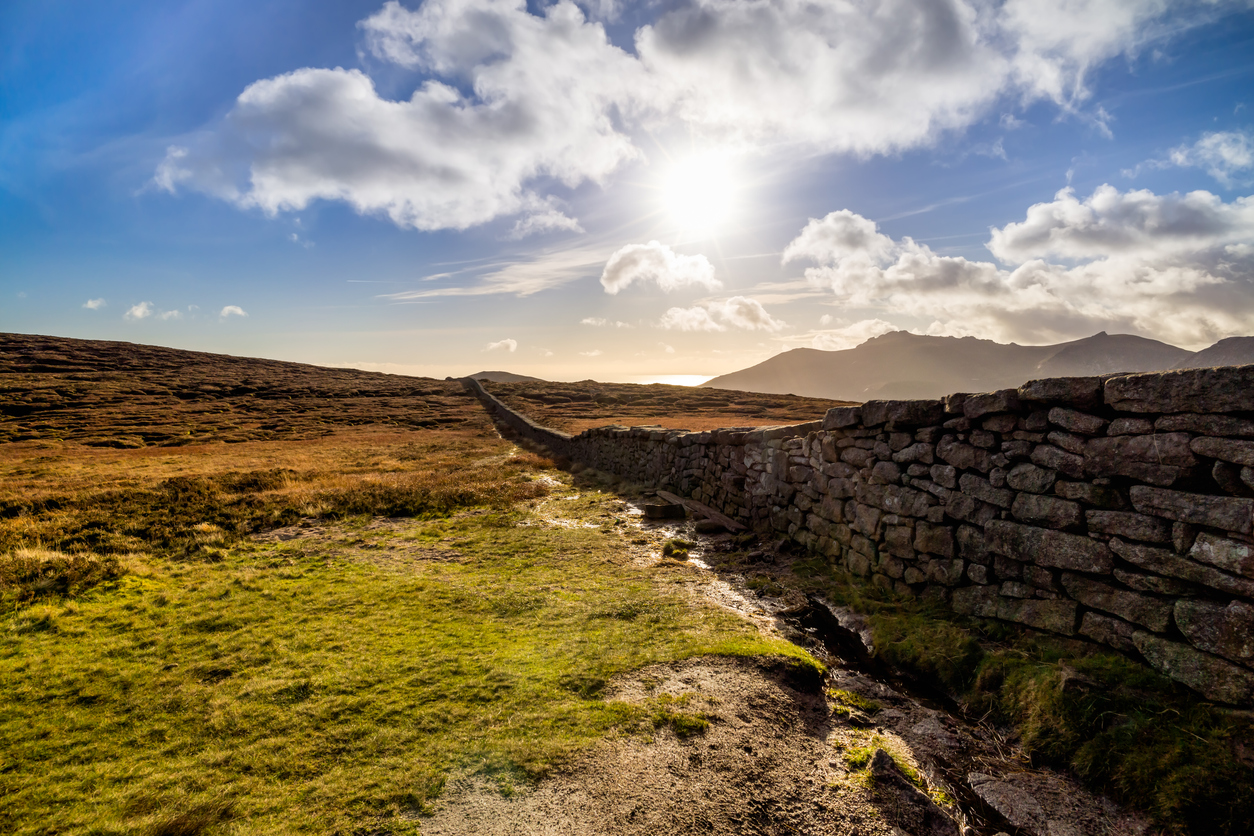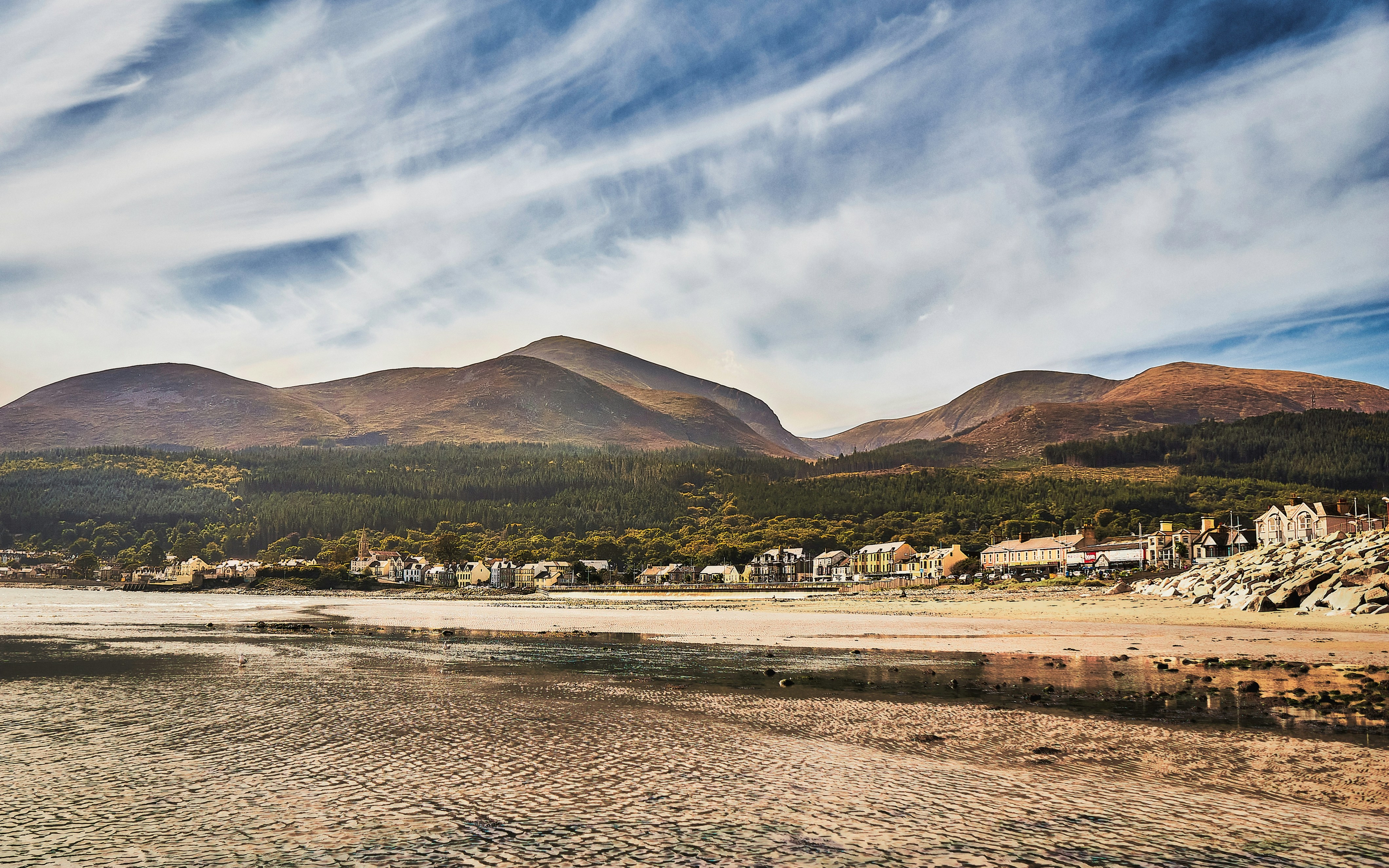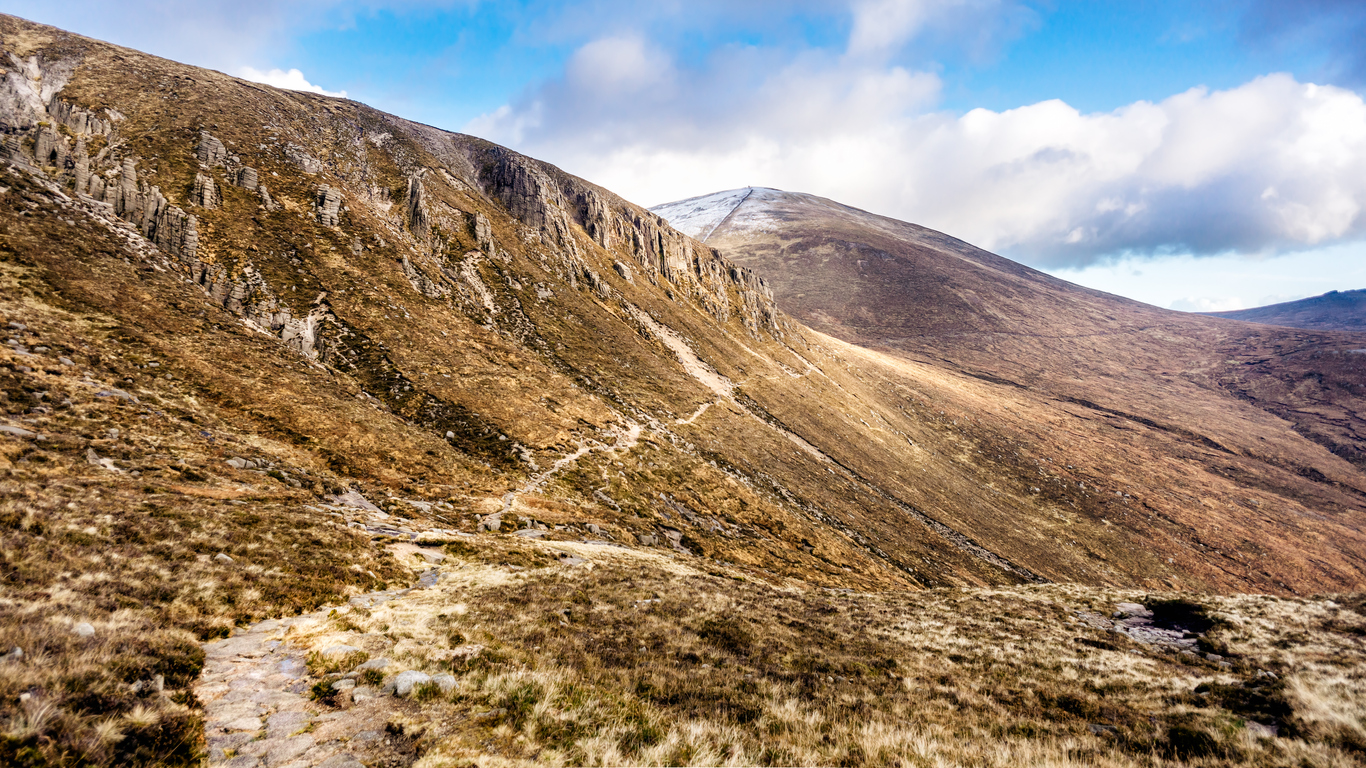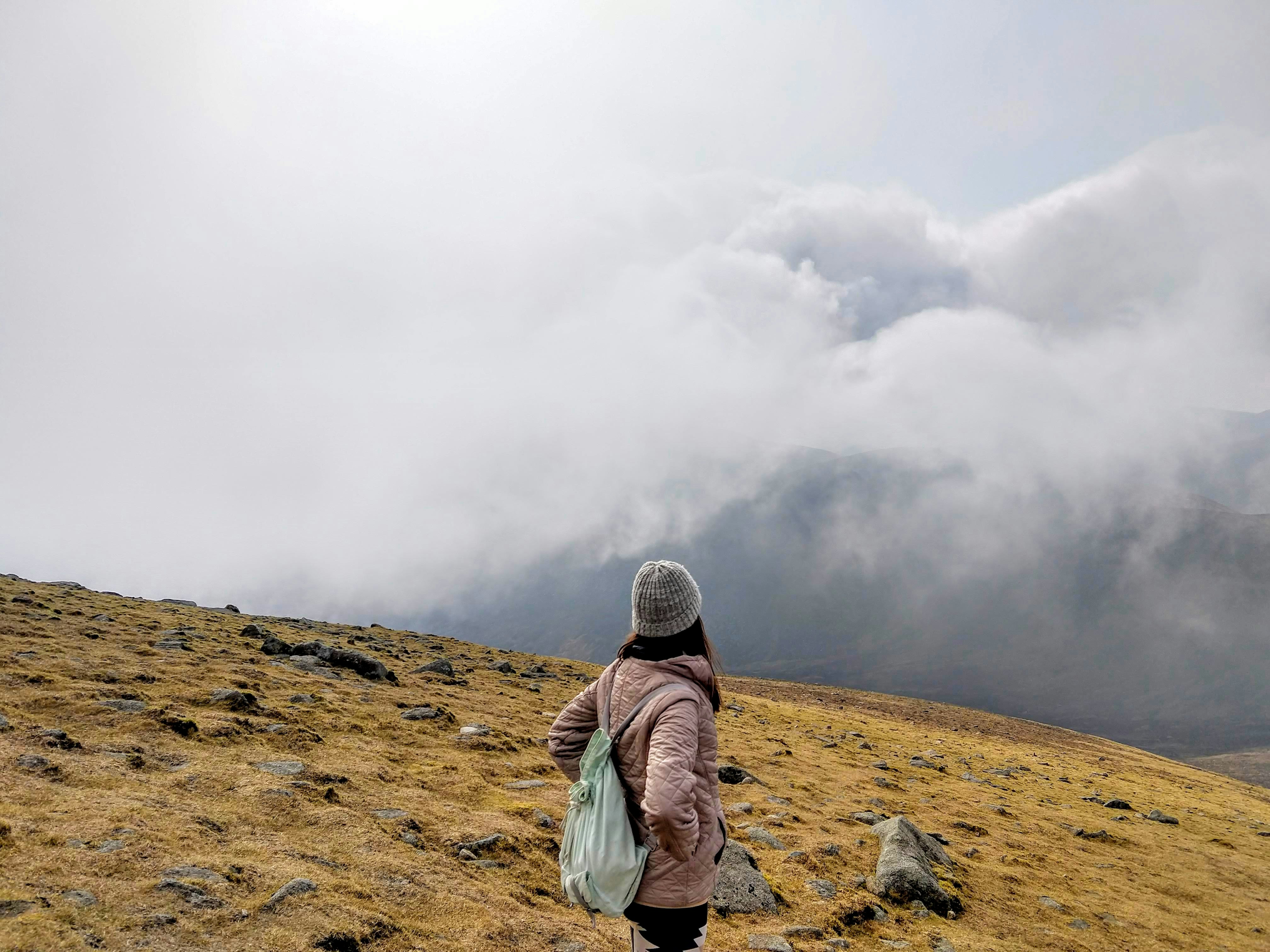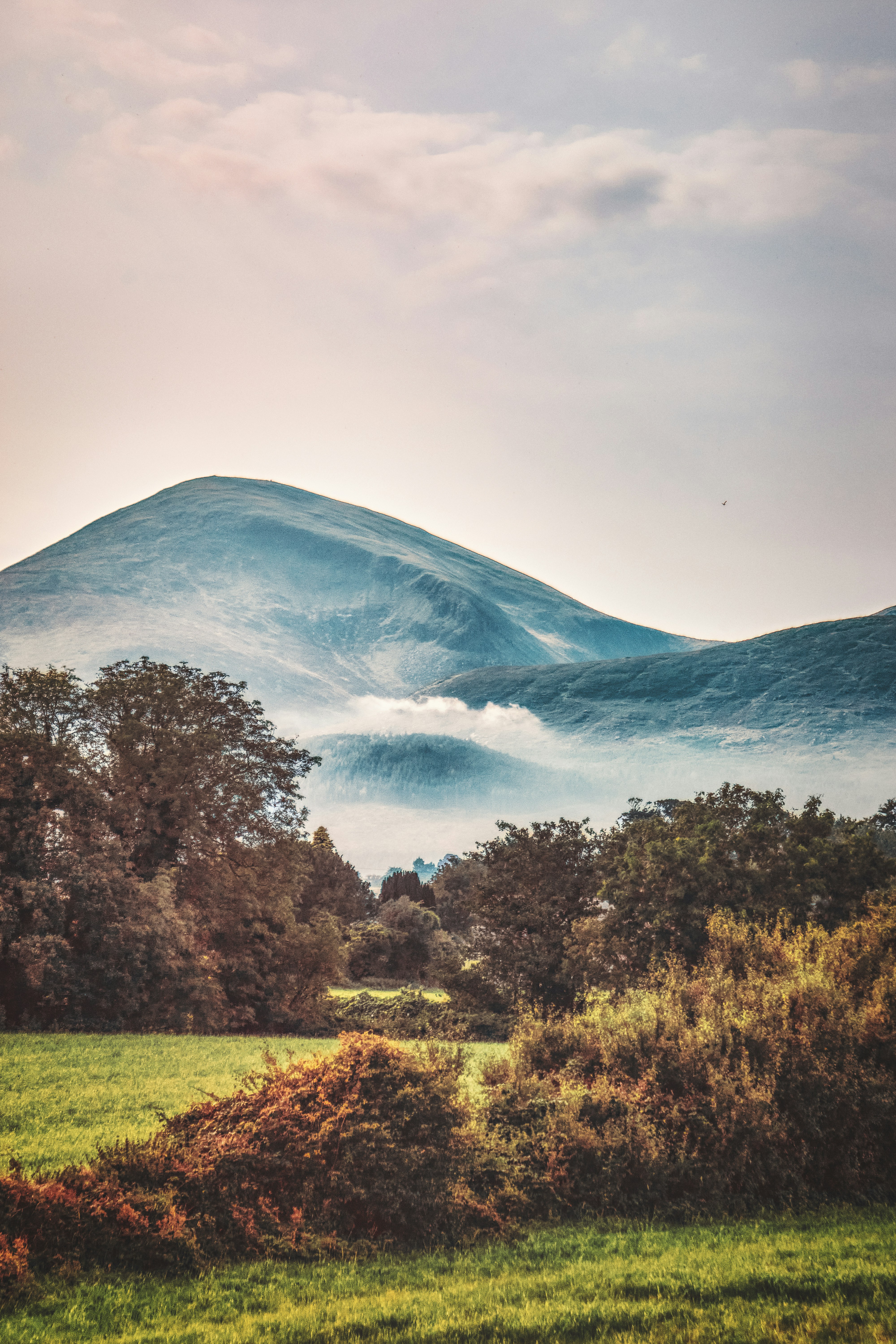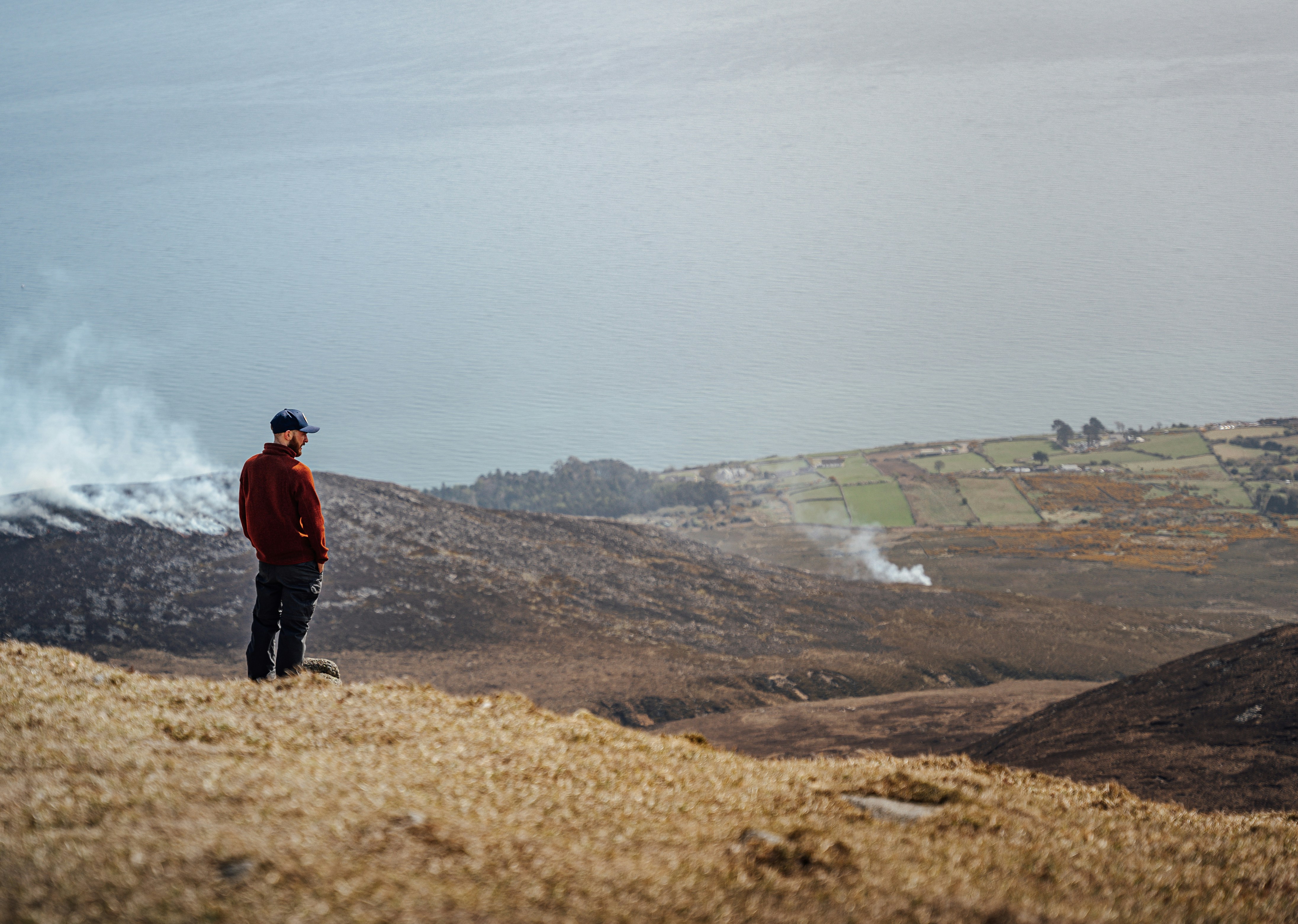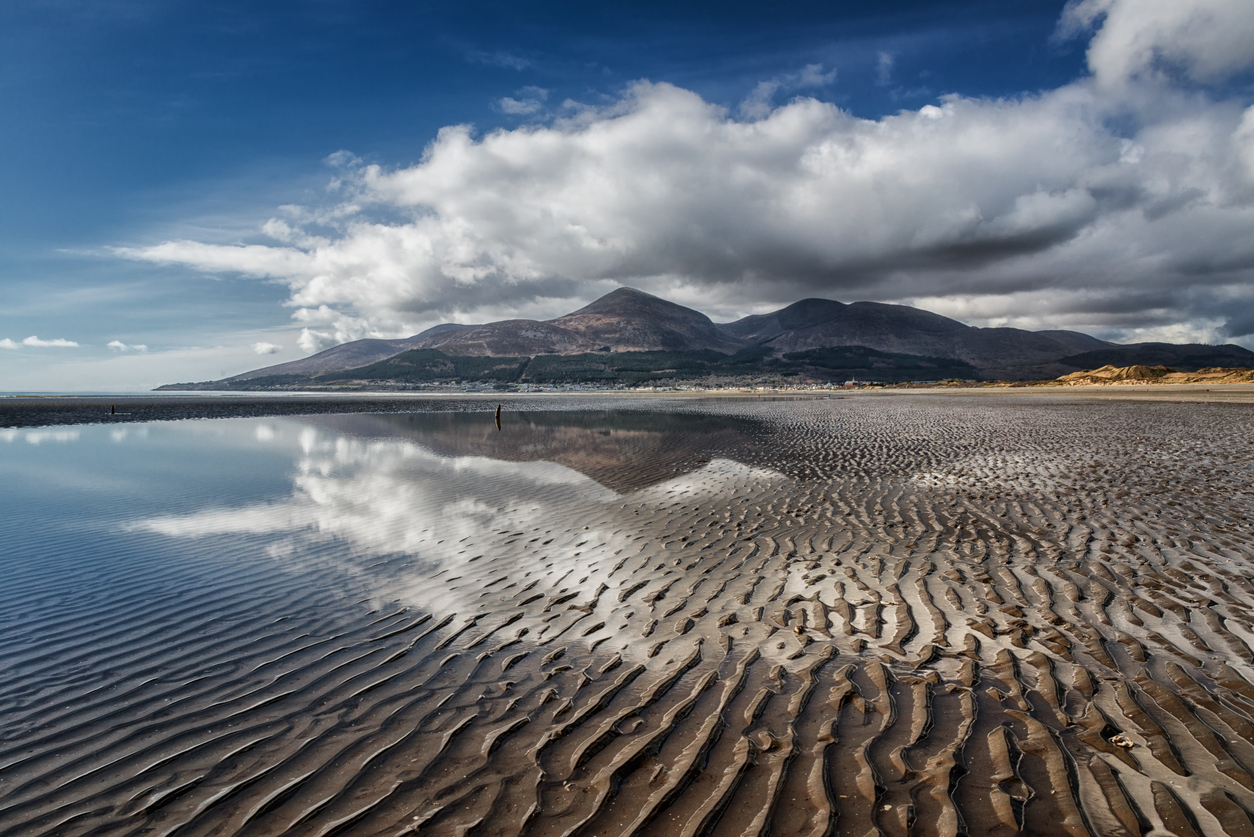Standing tall amongst the scenic Mountains of Mourne is Northern Ireland's highest peak - the mighty Slieve Donard. Towering 850 metres above the coastal town of Newcastle in County Down, Slieve Donard offers unparalleled views and exhilarating hikes for adventurers of all abilities. Whether you're a seasoned hillwalker looking to bag another peak or simply want to appreciate the fresh sea air, Slieve Donard has something for you. Family-friendly trails weave through purple heather and emerald green landscapes, leading up the mountainside at a relaxed pace. For those seeking a more challenging climb, the steep, rocky path to the summit will get your blood pumping whilst surrounded by the region's incredible beauty. The Mourne Mountains have been drawing visitors to Newcastle for over a century. Back in 1896, the Slieve Donard Hotel first opened its doors, enticing travellers with the promise of being a gateway to the area's natural wonders. To this day, the elegant Slieve Donard Hotel still provides luxury accommodation overlooking the twinkling Irish Sea and sandy beach - the perfect base to explore the mountain range.
Hidden Surprises on the Lower Slopes
The imposing peak of Slieve Donard may dominate the skyline, but the lower slopes hide many surprises for those venturing onto the mountain. Crisscrossing the grassy foothills are numerous walking trails catering to all abilities.
The Glen River Trail
The Glen River trail is an easy-going family-friendly route following a rushing river and rainbows of wildflowers in summer. The vista unfolding across the valley makes the gentle incline effortless. The lush landscape also conceals the remains of long-forgotten homesteads and villages. Families will love the gently winding grassy paths that trace the lazy curves of this peaceful stream, with purple foxgloves and creamy meadowsweet nodding in welcome. Wander along as the valley unfolds to unveil vistas across the green foothills towards the mountains rearing up majestically ahead. Pause to picnic on the riverbanks under the dappled shade of ash trees. Vestiges of the bygone settlement also hide discreetly along the Glen River trail. Keep an eye out for original stone walls made from the area's distinctive granite marking the boundaries of long-vanished farmsteads. At one point stands an abandoned cottage, roofless but etched with a fading mural of a white horse and the long-gone farmer trotting home along the river trail. It is now a haven for wildflowers but once rang with jubilant Gaelic songs or farmers calling in their cows.
The Pigeon Rock Trail
Less relaxing but immensely rewarding is the steeper Pigeon Rock Trail that zig-zags upwards through heather blooms in purple and green. The higher you climb through the lower slopes, the more exhilarating the views across the Irish Sea and secluded bays below. Pant up towards Pigeon Rock, the path squeezing between the natural fortress of craggy rock faces looming close overhead. Here sure-footed peregrine falcons nest in crevices, swooping and wheeling majestically on the updrafts. Peer back down over the trail and travelled too far below. The ominously named Chimney is a sheer natural cleft plunging precipitously down between towering cliffs. Fortunately, the Pigeon Rock Trail rises more gently to enable you to catch your breath whilst surrounded by natural beauty. From this elevated vantage point, you can glimpse the misty outlines of Wales' peaks beyond the water. Just be sure to avoid the edge and watch children and dogs!
Bog Lands and Blackberry Glades
Skirting behind the steeper slopes lie spongy tracts of bog land that once trapped unwary wanderers but reward those who explore further. Squishy sphagnum moss and sweet bog myrtle brush-soaked trousers as you delve into a wilderness barred from distant views. Solitary windswept rowan trees clutch the poor soil as stranded remnants from primordial forests. Sudden outcrops of granite boulders rear up, deposited by Ice Age glaciers yet seeming bizarrely out of place. Yet from late August, follow faint desire lines foraging deep into the shadowy bogs and you'll stumble into secluded glades dripping with sweet juicy blackberries. These humming wild spaces become places of vibrant colour as children splash purple berry juice up to their elbows. Fill punnets eagerly but leave plenty of fruit behind on these arching brambles that adorn the lower slopes. Their presence hints at the hidden delights that await off the beaten track on Slieve Donard!
The Rewarding Climb to Slieve Donard's Summit
Reaching the summit of Slieve Donard is no easy feat, but the rewards are truly spectacular. The sweeping vistas that unfurl across County Down and beyond will take your breath away almost as much as the climb itself!
Hare's Gap Trail
The most popular route up Slieve Donard is along the stony Hare's Gap trail leading directly to the top. Be prepared for a tough, steep hike covering uneven granite steps and loose stones requiring stamina and strong footwear. Yet the rewarding views will motivate you onwards and upwards! Scramble your way up age-old stone stairways constructed painstakingly by hand over the centuries by sheep farmers and quarrymen. Breathe deeply the crisp fresh mountain air as you traverse boulder fields left behind by the huge glaciers from the last Ice Age that carved this impressive landscape. Cresting the saddle of Hare's Gap itself, the imposing peak towering overhead comes into tantalising view, framed by the Mourne Mountains' velvety green lower slopes.
Changeable Mountain Weather
In these lofty climes, the mountain weather can alter rapidly so gear up wisely before tackling the upper slopes. The seasoned hiker always carries extra layers, hats and gloves even during fine spells. For the capricious winds show no mercy up here! One minute visible sunbeams pierce cotton wool clouds to cast rainbow spotlights dancing magically over the craggy landscape. The next, thick fog can envelop the barren granite-strewn reaches in minutes. But with luck and good preparation, you may be rewarded by glorious vistas reaching right down Northern Ireland's eastern coastline to Scotland or even rare glimpses of distant islands hovering on the hazy horizon.
The Windswept Summit
At first glance, Slieve Donard's summit may seem a bleak and forbidding moonscape. But surprisingly fragile arctic-alpine flora thrive in this remote habitat along with hardy native fauna. Curious Herdwick sheep and sturdy Irish hill ponies contentedly graze the thin meadows threaded amongst boulders. Delicate saxifrages and lady's bedstraw gamely flower up here too, tenaciously sprouting wherever a pinch of soil lodges. And craggy granite outcrops emerge from the shattered rubble like whales' backs, providing a staircase to the very apex. Here on a fine clear day, an exhilarating 360° panorama unfurls down across crazy paving stone fields and hamlets nestling towards the glittering sea below. To the east lies Scotland, south the sparkling expanse of the Irish Sea stretching over to Wales, while westward spread patchwork fields towards Sliabh Guillion's hazy blue dome. From this transcendent viewpoint 850 metres high, master of all you survey, you can understand the raw magnetic allure that draws visitors up Northern Ireland's loftiest peak. Just brace against the biting southwesterly wind before turning to face the descent down towards more gentle climes.
Relaxing after Your Mountain Adventure
Whether you make the ascent on foot or admire Slieve Donard from afar, there are plenty of ways to relax weary limbs afterwards. The traditional base for Mourne Mountain adventures is the coastal town of Newcastle. Its attractive promenade overlooks the slopes of Slieve Donard and offers an inviting stretch of golden sand lapped by the Irish Sea.
Newcastle's Golden Beach
After a long, exhilarating hike up Slieve Donard's towering slopes, few things are more blissful than emerging back down at Newcastle's beautiful Blue Flag beach. Simply stroll barefoot along the endless tideline of golden sand washed by aquamarine waters, breathing deeply the restorative sea air. Gaze back up at the mighty mountain peak gazing impassively down as you paddle and let tiny waves lap away sweat, offering their benediction on your efforts. For more breathtaking views, try beach yoga stretching muscles against a panorama of Mourne green foothills sweeping into the ocean beyond. Or just find a sheltered hollow out of the breeze to bask lazily, nibbling fish and chips whilst watching surfers catch crystalline waves offshore.
Coastal Delicacies
When you've worked up a hearty appetite from hiking Northern Ireland's highest peak, nowhere better to refuel than Newcastle's eclectic cafes and restaurants. Tuck into just-landed seafood sourced steps away along the County Down coastline - from plump Greencastle prawns to creamy Carlingford oysters. Try dulse, nutritious purple seaweed harvested locally, instead of crisps with your craft ale from nearby Mourne Mountains Brewery. Or line your stomach with a hearty Ulster fry-up, packed with traditional meaty specialities and griddled soda farls. Wherever you choose to dine after your exertions up on high, expect fresh, seasonal fare courtesy of Slieve Donard's bountiful coastal location. That ocean views through sunny windows will taste all the sweeter for originating just downhill from Northern Ireland's lofty summit!
Soothing Spa Luxury
After an exhilarating yet demanding climb up Slieve Donard, treat yourself to some rest in Newcastle's fabulous spa hotels. The iconic Slieve Donard Resort and Spa offers indulgent pampering - just what you deserve post-hike! Choose from relaxing massages, nourishing seaweed wraps or cleansing marine facials whilst gazing through panoramic windows at twinkling yellow lights along the dusky beach. Next, unwind further tension in the spa's gleaming hydrotherapy pool or unwind stiff limbs in the herbal sauna breathing in therapeutic essential oils. Finally, float blissfully back to your elegant room, perhaps enjoying an expertly mixed sea salt martini on your private balcony. Then snuggle down as the last peach rays fade over the slumbering summit, serenaded by the soothing whisper of waves lulling the mighty mountain to sleep.
Exploring Beyond the Peak - Secrets of the Surrounding Area
The bustling seaside town of Newcastle makes a perfect base to explore Slieve Donard thanks to its golden sandy beach, colourful cafes and luxury spa hotels. But what secrets do the patchwork fields, tranquil villages and forest parks surrounding the iconic mountain hide? Venture inland and you'll discover there's more to County Down than its lofty summit.
Tollymore's Enchanted Woodlands
Nestled at the foot of Slieve Donard lies the magical realm of Tollymore Forest Park. Generations of visitors have adored exploring its maze of woodland trails, stone bridges and babbling waterfalls. Rambling through the trees, you half expect to meet fairy folk and woodland sprites hiding behind the knotted oak trunks. Fantasy novelist C.S. Lewis reputedly found inspiration for his Chronicles of Narnia whilst walking in Tollymore's enchanting wilderness. Seek out the park's Gothic follies peering from the woods, their grey stone fronts carved into dramatic grottos and churches. Peer closer to spot intricate mosaics illustrating Celtic myths about giants and stags, created to embellish Tollymore’s magical aura. And clamber down stone steps glowing emerald with moss to uncover the park’s pride and joy - a tumbling cascade of waterfalls that seem to embody the very spirit of the forest.
Tracking the Shimna River
Leaving the oak woods behind tracks lead down through the park beside the sparkling Shimna River flowing from high up in the Mourne Mountains. Follow this refreshing ribbon downhill as it gushes seawards past the remnants of bygone local industries. Pause at the broad packhorse bridge with multiple arches that once transported huge granite blocks quarried from the mountains above. Continue as far as the crumbling walls of abandoned grain mills and linen works that once relied on the fast-flowing waters of the Shimna winding through the valley below Slieve Donard. Today salmon still struggle upstream during the autumn spawning season, battling bravely past rapids and weirs. Take time also to admire the kingfishers and sandpipers that thrive along these unspoiled banks. Find a flat sunny stone to perch alongside the dancing current, watching for the electric blue flash marking the arrival of a kingfisher. Then peer closer into the whorls and eddies to catch the speckled flick of wild brown trout rising.
Historic Castlewellan Town
Just a fifteen-minute drive inland from Newcastle unfolds the unique market town of Castlewellan, echoing surprising hints of European style thanks to its unusual history. Stroll the spacious tree-lined boulevards and square more reminiscent of Paris than Ulster, flanked by elegant Italianate villas and boutiques. This subtle continental charm stems from the settlement's French Huguenot roots when persecuted weavers fled here in the 1700s at the town founder's invitation. Yet beyond the bourgeois boulevards, Castlewellan also hides more surprising sights perfect for curious ramblers. The sombre Faces of War statue gazes grimly across a Victorian castle lake lined by exotic blooms as if remembering Slieve Donard and the Mourne Mountains' traumatic past. And what stories might those inscrutable Egyptian sphinxes overlooking the solemn scene tell about this area's remarkable heritage? After appreciating the mountain itself, come uncover Castlewellan's secrets to explore the full picture of this region shaped profoundly by Slieve Donard's looming presence.
Related Articles

Let us know you agree to cookies
We use marketing, analytical and functional cookies as well as similar technologies to give you the best experience. Third parties, including social media platforms, often place tracking cookies on our site to show you personalised adverts outside of our website.
We store your cookie preferences for two years and you can edit your preferences via ‘manage cookies’ or through the cookie policy at the bottom of every page. For more information, please see our cookie policy.

